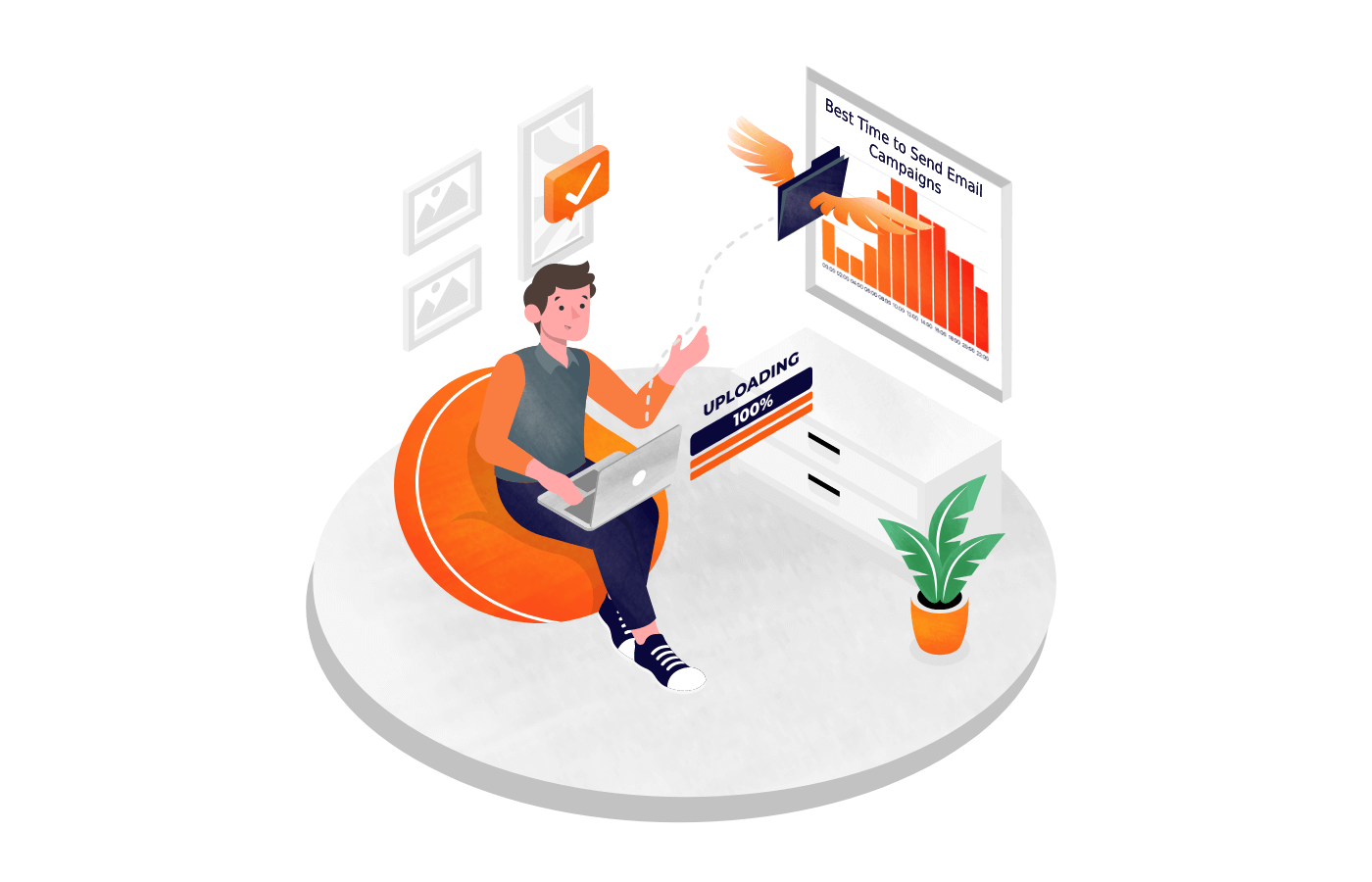Such little things as when the subscribers receive your email can make or break your email marketing performance. When one-fifth of all emails are read within an hour, deciding which hour of which day it will be is crucial. After all, it influences such metrics as click-through rates, click-to-open rates, and open rates.
These performance-measuring trackers can inform you whether your EDM (electronic direct mail) marketing is working or just sucking money out of your business.
So, how do you bulletproof your email marketing campaign send-out time so your audience is hooked instantly and hits the CTA button? You determine when your audience or community will engage with your email depending on the message’s type and purpose, your audience’s time zone, and digital behavior.
Let’s look at the best times to send your marketing emails based on the email campaign and other factors one by one in this blog post.
Best Time to Send Marketing Emails
Let’s admit — everyone’s email inbox is packed with stuff they don’t read. On average, two-thirds of people have unread emails in their inbox — 1602.
How do you plan your campaigns in a world where emails are ignored? A logical assumption is that emails at the top of your inbox will likely be viewed and opened. So, you need to time them well. Here are a few insights:
- Your sending schedule should depend on the industry you’re into;
- Tuesdays and Wednesdays are the best days to send marketing emails for B2C and B2B companies;
- Sundays are the least effective days to send campaigns for a B2B brand.
Test different send times and let your data decide when your audience is most active.
With Sender, it’s easy and you can even do it for free!
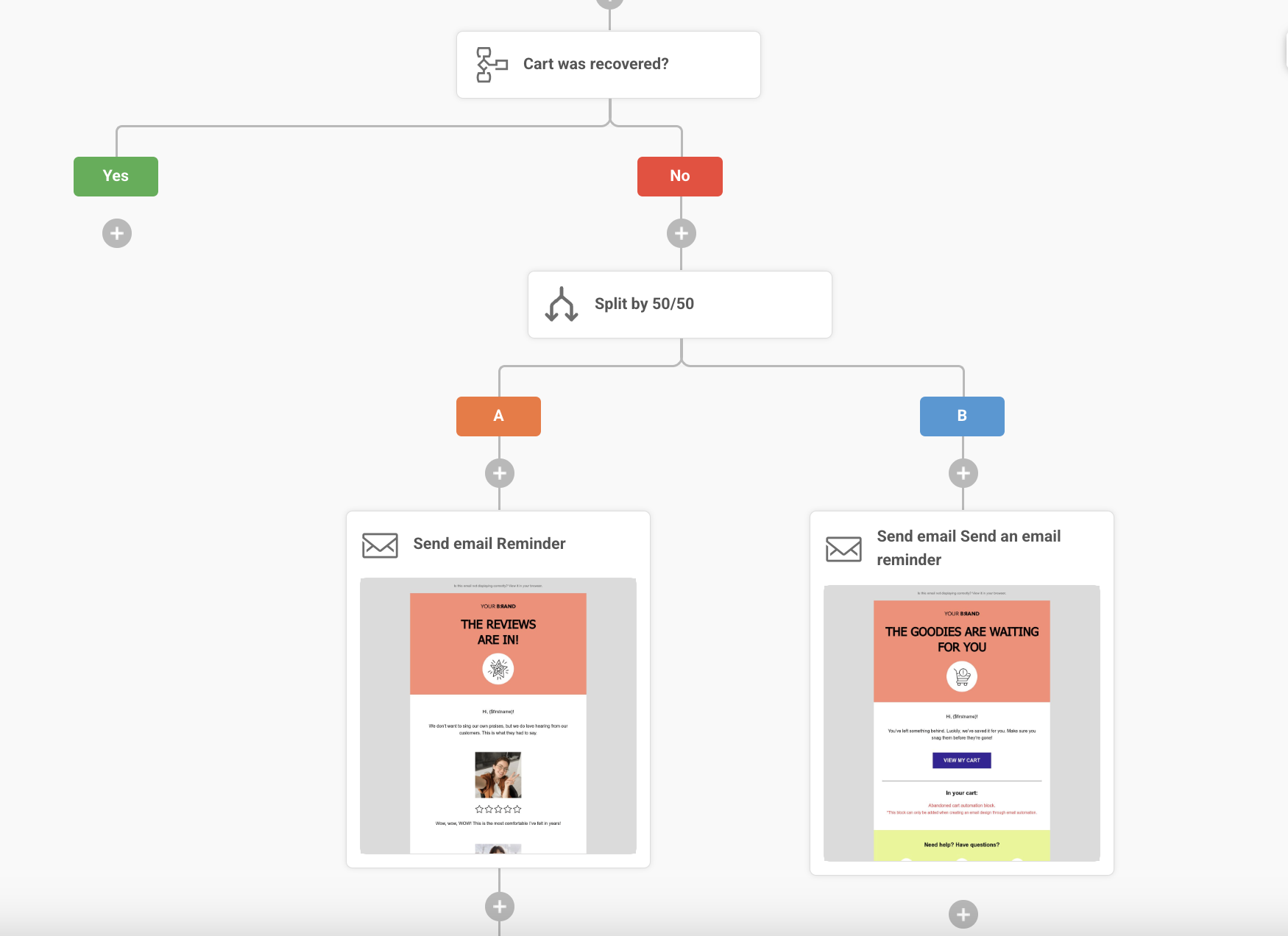
Why Does Email Timing Matter?
Sending an email at the right time can potentially improve your email campaign success rates. Timing the messaging right helps you stay relevant, be seen more often, and engage with your subscribers better. Here are some of the reasons why email timing matters:
- Improved open rates. Knowing when your subscribers are most active and timing your campaigns around that time helps improve the odds of your email being opened.
- Maximized click-through rates. When your audience is engaged, they’re most likely to click on links within your email. So, timing your emails appropriately matters a lot in increasing click-through rates.
- Heightened competitive standing. Your audience will appreciate your thoughtfulness when they receive the right email at the right time. This will give you a competitive edge and increase your value in their life, which will help defeat competing for their attention with other brands.
- Increased target audience reach. Your target audience will appreciate you for sending an email when they want to read more about you. Plus, it increases the chances of referrals, increasing your reach and engagement.
Best Time to Send Email Newsletter by Type
Each type of email comes with characteristics that dictate the right time you can send it. For example, you’ll want to send an invitation email a few weeks before the event, a survey email when you want feedback, and an abandoned cart email a few hours after.
The type of email commands the optimal time decision in email marketing. Here is a breakdown of the best time to send sales emails and newsletters according to the type:
Newsletters Emails
If you’re searching for the best time to send a newsletter to your US-based subscribers, you should keep the following in mind:
- People prefer to receive newsletters during the daytime or late evenings so that they can read at night before bed;
- Also, Thursdays and Saturdays are a no-go — they receive the lowest open rates;
- The best time to send marketing emails occurred on Fridays, Mondays, and Wednesdays between 3:00–7:00 a.m. in the early morning or after late afternoon.
So, according to industry wisdom and proven campaigns, it’s best to send out email newsletters on Friday, Monday, or Wednesday.
But if you do it on Monday, the recipients might not open the email until a few days later. The best time to send a newsletter is between 10:30 and 11:30 p.m. or between 3:00 and 6:00 a.m. when recipients start their day. If we dive deeper and find the exact times, we’ll find that the best time to send newsletters is between 3:30 and 5:00 a.m. on a Friday.
Emails sent within this period register up to a 25% open rate, per the data we shared in the previous section. It’s not too shabby for a newsletter campaign.
Also, if you’re wondering when you should avoid sending your weekly newsletter, that would be between 9:00 and 11:00 p.m. on Saturday for your US subscribers. This will give you a less-than-favorable open rate of below 20%.
The above advice should be taken with a grain of salt if your target audience is:
- Young (under 25)
- Spend much time on mobile devices
- Unevenly spread across the world (hint: time zones)
Also, most people check their emails on a Friday evening if they’re in the entertainment industry.
Key Takeaways
- Best days: Monday, Friday, Wednesday
- Best time: 3:00–7:00 a.m, 6:00-11:30 p.m.
Mass Emails
Different from the over-the-counter newsletters that are neatly crafted in advance, mass email blasts are known to be much more sporadic. When sending a mass eBlast or bulk emails, it’s advisable to determine when the audience is likely to open their inboxes. A good way is to track their online behavior and segment your list based on their online activity.
But if you’re just getting started and need a general rule of thumb, plan to send or schedule your mass emails between Friday and Monday when the recipients are more likely to open them. Here’s some insight on when’s the best time to send mass emails:
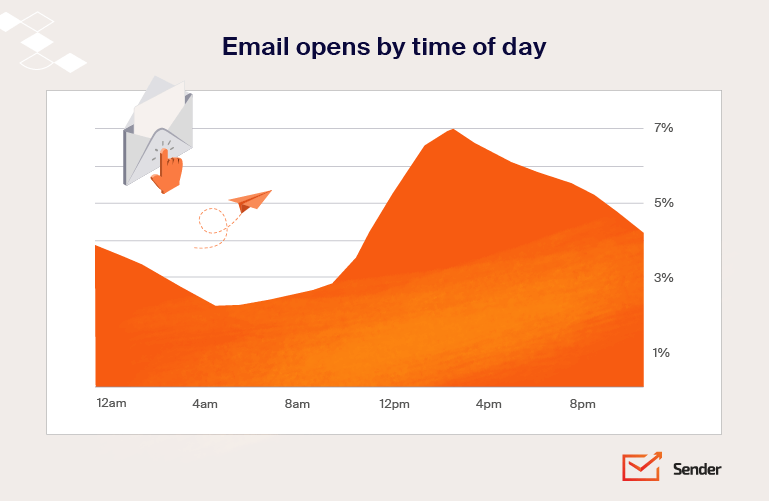
The peak time for sending email blasts is between 10 a.m. and noon. This is when most people start feeling the need to take that mid-afternoon break and check their inboxes. Your time to shine can be prolonged up to 4 p.m., but once the clock hits 6, your chances of getting noticed start to decrease.
Does this mean you can’t send your audience those artsy sales ads or posters about the next-week event for the rest of the day? Not really. You can still drop them if you know they’ll get opened and clicked through. There’s always the A/B testing that will help you better understand your customers’ behavior. Apply it to every email type discussed in this article, and you’ll get your results sooner than anticipated.
Key Takeaways
- Best days: Friday to Monday
- Best time: 10:00 a.m.-noon, 14:00-6:00 p.m.
Promotional Emails
Brands generally send promotional emails as and when they please. But there are better strategies than that, especially when you want to improve your email marketing KPIs. Scheduling promotional emails at the right time helps increase CTR (click-through rates) like any other email campaign.
Since promotional emails are unsolicited, you should make them instinctive (and spontaneous) for the recipients to open and read. So, scheduling them when subscribers are on their devices is best, or you risk getting lost in a crowded inbox.
The best time to send promotional emails is Friday at 11.00 a.m. This time is perfect for maximum engagement if your subscribers are US-based. Remember, always research your audience and use the following tips to get the best results:
- Test multiple time slots to find the best time as per your audience;
- Analyze open rate, clickthrough rate, and engagement data to find the best times;
- Adjust sending times for holidays and relevant events;
- Personalize content, offers, and subject lines for higher engagement.
Key Takeaways
- Best days: Friday
- Best time: Around 11 a.m.
Transactional Emails
When one says ‘transactional email’, they imply that these include the emails you receive after a transaction. For example, an order confirmation email. This appears self-explanatory – you send them out as soon as the customer has interacted with your business.
But what if we told you this is only sometimes the right thing to do? Since email marketers put a big emphasis on open rates by the day, it’s not surprising that engagement ranks the highest among the motives for adopting the practice of sending transactional emails. It makes sense – an engaged customer is bound to stay loyal to your brand.
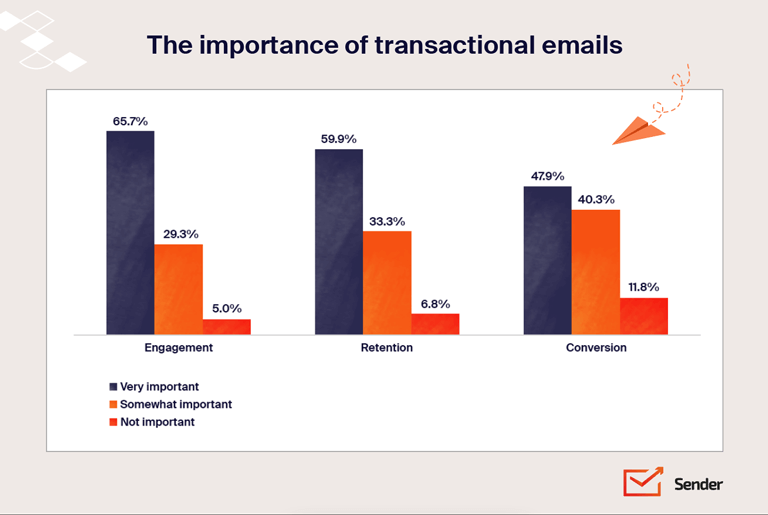
That said, it’s easy to overdo it when hoping to engage, retain, and convert the potential client. The ‘everything goes’ approach can lead businesses to come off too strong and scare these customers away with emails that are sent too quickly or too often.
Fair – sending a ‘thank you for your order email right after the customer has purchased something from you should be your standard practice. The same goes for a password reset email timing.
On the other hand, an abandoned cart email can wait a little longer. With the former, it’s clear that the customer is already interested in your offer. But there needed to be more trust, a high shipping cost, or a payment/technical issue that stopped him from making the order. In this case, your best bet would be to:
- Send your first transactional email within a few hours of the abandoned cart as a reminder;
- Send the second one 24 hours after the event to give him some time to ‘sleep on it’;
- Send the final email a week after the event with a discount to lurk him in.
Key Takeaways
- Best day: The same day the transaction was made
- Best time: A few hours after the transaction
Welcome Emails
Making the right first impression can be challenging for modern email marketers. It’s even tougher if you’re in a competitive, cut-throat industry that doesn’t tolerate mistakes. The silver lining is that welcome emails tend to get some of the highest open rates. The average 15-25% here turns into a whopping 50%. According to Marketing Sherpa, they turn out to be 86% more successful than newsletters.
This should give you some peace of mind that comes from knowing that you can shoot high with these emails. But just how high exactly?
For welcome emails to work, it’s recommended that you adhere to the following 3-step process:
- Send out your first welcome email straight after the prospect has signed up/subscribed to your newsletter/service. You have to use this time to your advantage because your brand is still fresh on his mind;
- Depending on whether or not the prospect has purchased the initial email, you should either lead him on by sending a second one from the welcoming email series or resorting to the transactional email if the purchase is already made;
- The third and final welcome email should reach the prospect’s inbox about two days after the original email. By including the appropriate content and sending it later, you ensure that he receives the intended message and [finally] converts into a customer.
If this didn’t happen for some reason, you should add him to a different email sequence to persuade prospects to purchase. This advice suits ecommerce companies whose offerings are simple to understand in 3 emails.
If you’re a tech startup or a payment processor app, you might need more than just these three emails to convey the message and not leave out anything important entirely. So, decide on the number of welcome emails at your discretion and follow the above steps to schedule your welcome emails accordingly.
Key Takeaways
- Best day: The same day the subscription was made
- Best time: A few hours after subscribing
You might also be interested in these 27+ appointment email examples that will make scheduling appointments way easier.
Email Follow-ups
Next, we have follow-ups – the most time-sensitive emails that can yield excellent results when schemed out well. You’d be shocked to discover how many businesses avoid sending follow-up emails to their prospects. It was reported that out of 1000 companies, less than 3% follow up with their potential customers.
This is staggering — imagine how many opportunities these companies waste!
Whether it’s the lack of patience or, more likely, the lack of a well-defined strategy, the losses continue to accumulate when you don’t factor in the busy person who might need more time to open up your email. And you’ve already given up.
To not be one of those companies, consider appropriating these email follow-up tips:
- If the customer reaches out to you, a prompt response is vital. If it’s the other way around and you still need to receive the response, waiting 3-4 days before sending a follow-up email is mandatory.
- Mondays and Fridays are off-limits. You should refrain from following up with your prospects these days.
- Tuesdays and Wednesdays at around 10 a.m. work best for sending these emails. People are considered to be the most productive these days, so they check their inboxes with intention more frequently.
- Saturdays at 10 a.m. and Sundays at 8 p.m. are acceptable for clients who are entrepreneurs themselves and those who plan their weekly schedule ahead of time.
According to industry statistics, most emails are forgotten after the first 24 hours. So, you should have a follow-up sequence. Also, there’s a 21% chance of getting a response to your follow-up email if the first email needs to be noticed.
Pro Tip: Marketing automation or email scheduling software can help you determine when to send follow-ups and other emails when unsure about your customers’ behavior. Once you get more insights, you can use this software to mitigate pressure from your customer service reps by planning your emails.
Key Takeaways
- Best days: 3-4 days after a user does an action, you follow up on;
- Best time: Around 10 a.m.
Cold Emails
Recipients are likelier to click cold emails when they appear on top of their inboxes. So, send them out early, between 6:00 a.m. and 9:00 a.m. at the start of the workday.
As they settle down to open their work emails, the recipients are more likely to open and respond to your emails.
Key Takeaways
- Best days: Business days
- Best time: 6:00-9:00 a.m.
B2B Email
B2B emails contain sales enablement or marketing material for business professionals, enterprises, and companies from other businesses.
You can choose any day, Tuesday, Wednesday, or Thursday, to send a B2B email. Also, if you’re looking for the best time to send a B2B email, you should send it between 5:00 and 7:00 a.m. However, most of the time, the recipients are located in multiple time zones. It may not be possible to time the message for each contact every single time. So, stick to general optimal times for the most effective campaigns.
Key Takeaways
- Best days: Tuesday, Wednesday, Thursday
- Best time: 5:00-7:00 a.m
B2C Email
B2C emails are targeted directly at the end consumers to create awareness, increase sales revenue, or promote your products. While such emails are an essential part of an ecommerce email strategy, there’s a common misconception that you can send a marketing email anytime.
In reality, you should send marketing emails to a B2C audience when they’re most active.
According to research, the B2C target audience is most active during late evenings. So, sending email campaigns on Fridays or Mondays late evening after 9:30 p.m. will work best.
A good way to find the best time to send actionable emails is to test campaigns at different times. Analyze when you get the best open rates, engagement, and clicks, and plan B2C email campaigns accordingly. Additionally, here are some tips for timing your B2C campaigns:
- Test different days of the week for variations in open rates.
- Segment audience based on time zones for optimal delivery and engagement rate.
- Use marketing automation tools for scheduling and personalizing emails.
- Consider the nature of your business and subscriber interests when deciding send times.
Key Takeaways
- Best days: Friday to Monday
- Best time: After 9:30 p.m.
Best Time to Send Email Blast by Weekday
When is the best time to send an email based on the day of the week?
While business days have the highest open and engagement rates, they differ. Here is a breakdown of the best time to send emails based on actual data:
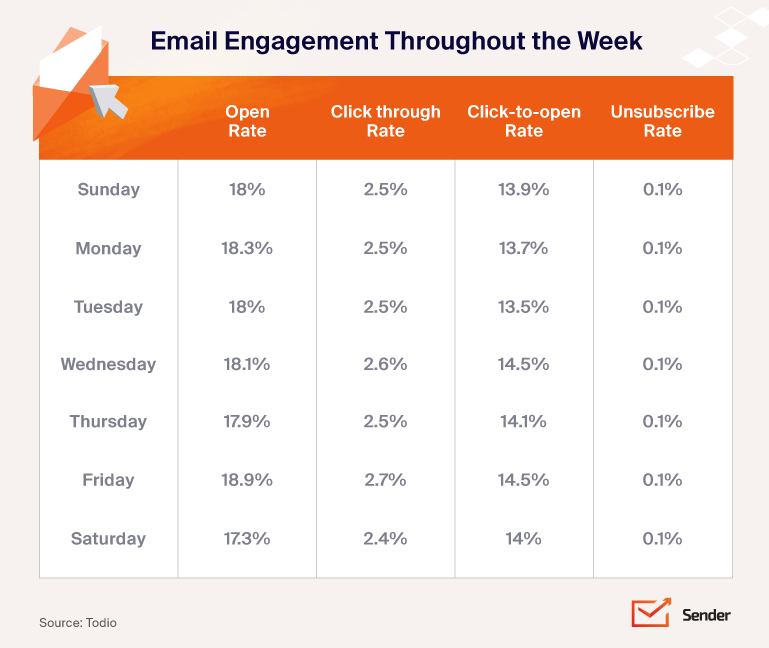
According to the data shared above, here are the best days of the week to schedule and send an email:
- Friday: Friday registers the highest open, click-to-open, and click-through rates.
- Wednesday: Wednesday is the second-best day to email if you consider all three metrics overall.
- Monday: Monday registers the highest open rates after Friday but has slightly lower click-to-open rates than Wednesday, so it comes at a close third.
Let’s look at when you should send an email each day of the week. Generally, the optimal time to send emails is when recipients are more likely to click-to-open.
According to post-pandemic data, high open rates and click-to-open rates are registered late into the night after 11:00 p.m. for the US audiences, irrespective of the day. This confirms that people love to binge-watch (or scroll their mobile devices) in bed, late at night, and it can be the best time to send an email.
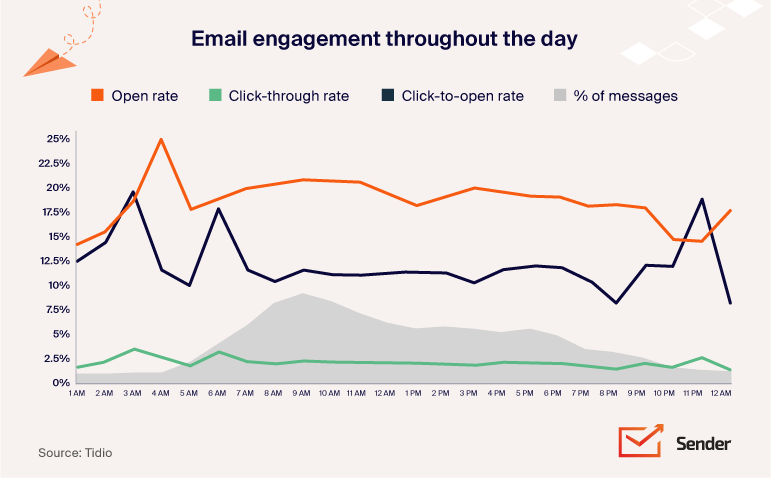
- On Friday: Existing evidence shows that emails sent on Friday perform the best. The day records the highest open rate (18.90%) and equally high Click-to-open rates (14.50%), making it the best day to schedule an email as an email marketer. If you talk about the best time to send an email on Friday, you should try sending it between 10:30 p.m. and 12:00 a.m. or between 3:00 a.m. and 7:00 a.m. for your audience in the United States.
- On Thursday: Research reveals that Thursday is a good day to send emails, with up to 17.90% open rate, close to Friday’s open rates. The best time to send an email on Thursday is between 2:30 a.m. and 5:00 a.m. for your subscribers in the US.
- On Wednesday: Wednesday is a good day to send an email, especially when targeting high click-to-open rates. It registers a click-to-open rate equal to a click-to-open rate on a Friday. The best time to send an email on a Wednesday is late into the night, same as Friday — between 10:30 pm and 4:00 am if you have a subscriber base in the US.
- On Tuesday: Tuesday is good for achieving nice open rates but fails to get decent click-to-open rates. In fact, it registers the lowest COR during the week. Sometimes, Tuesday emails perform well if you count the open rates, but if your goal is CTR or COR, it’s better to avoid scheduling a campaign on Tuesday.
- On Monday: Monday comes close to Friday regarding open rates. However, even though Monday emails have a good open rate, they have a lower click-to-open rate, which means lower chances of high conversion. Coming to the best time to send an email on Monday, you should schedule an email between 11:00 pm and 4:00 am for US audiences.
- On Saturday: You can send your emails on a Saturday. But don’t expect a stunning engagement on the weekend. Saturday scores excellent in the click-to-open rate but has lower open rates than other days of the week. So, you should consider it before scheduling an email on a Saturday.
- On Sunday: Sunday performs better than Saturday regarding click-through and open rates. But as people might be in the ‘entertainment zone,’ they convert less than on other days.
Measuring Your Email Campaign Performance
All said and done, consumer behaviors change dynamically and drastically, and every expert there has a different opinion on the best time to send business email campaigns.
When there’s too much noise, use the golden rule to measure the right metrics and do what numbers tell you. Your analytics will never lie and guide you to improve your campaign effectiveness. Here are the most relevant metrics that will help you find what time works best for you:
Open Rate (OR)
The open rate measures the email subscribers who opened your email.
OR = (Total number of email opens) / (Total number of emails sent out)
Assuming that you’re already landing inside the Inbox (and not Spam or Promotion) and have a catchy subject line and an optimized text snippet (second subject line), you should get a reasonable open rate for your campaigns.
Click-Through Rate (CTR)
Click-through rate refers to the number of people who click on the CTA (Call to Action) or link/image inside your email.
CTR = (Total number of clicks) / (Total number of opens)
It will always be less than the total number of emails opened because some users will open your email but ignore it after reading it.
Click-To-Open Rate (CTOR)
The last metric you’d want to keep a tab on is the click-to-open rate which compares the number of people who opened your email vs. how many clicked. This metric is crucial since it helps you understand whether the content in your emails is relevant and converting. If it’s not having the desired impact on the email subscribers, you can experiment with the design, copy, CTA, and content differently.
CTOR = (CTR)/(OR)
Using your analytics dashboard and finding these metrics will help you explore whether you’re getting the desired response. If you’re not achieving your goals, you can experiment with different times to send emails to your audience. Keep experimenting with campaigns until you get the desired results.
Focus on Testing Which Time Works Best for You
The biggest takeaway is that there’s no one-size-fits-all regarding the right time to send out emails. Many variables come into play – your company’s type, your customers’ behavior, your product/service – that will affect the schedule most suitable for your brand.
It helps to get to know your customers better – i.e., their needs and wants – and tailor your emails to them accordingly.
Don’t blind-test either – invest in A/B testing tools. They will guide you in the right direction so that it will get opened no matter if you send out that newsletter on a Tuesday morning or a Friday evening. This way, you’ll be able to find the best time to send email campaigns much more quickly.
Sources and Studies: Determining the Best Times to Send Emails
We examined 6 exclusive research studies to break down their discoveries:
- 2023 Email Marketing Benchmarks by GetResponse
- The Best Time to Send an Email [2023 Research] by HubSpot
- Best Time to Send Emails by Salesforce
- Perfect Timing: The Very Best Time to Send Email Newsletters by Wordstream
- When Is the Best Time to Send Cold Email? [2024 Study] by Siegemedia
- Best Time to Send an Email: Day, Hour, Industry [Data Study] by Brevo
Key Takeaways: Best Time to Send Emails
- Email send-out time is an important factor to consider in your email marketing strategy;
- There’s no one-size-fits-all when it comes to the so-called right time to send out emails;
- There are a lot of variables that come into play – your company’s type, your customers’ behavior, your product/service – that will affect the schedule most suitable for your brand;
- Always focus on testing based on your analytics, audience types, and campaign times to find out the best time to send sales emails;
- Consider performing A/B testing and pick the right time to send emails for your business.
To become a maestro of email marketing, delve into these exceptional articles we’ve curated:
- 13 Free Email Template Builders (HTML + Drag and Drop Editor)
- 9 Best Email Newsletter Software Compared (Free and Paid)
- 9 Best Mailchimp Alternatives for 2023 (incl. Free Competitors)
Best Time to Send Emails FAQs
When should you send a cold email?
Recipients are likelier to click cold emails when they appear on top of their inboxes. So, send them out early in the morning, between 5:00 a.m. and 9:00 a.m., so that it would be read during business hours. As they settle down to open their work emails, the recipients are more likely to open and respond to your emails.
What is the best time to send email to get a response?
You should send an email when the CTR is the highest if you’ve planned a campaign to get a response from your customers. According to the latest data, the best time to send an email to get a reply is at 10:00 a.m. on a Tuesday. Emails sent on a Tuesday at 10:00 a.m. generally have the highest engagement rates.
When is the optimal time to send an abandoned cart email?
There is no specific day or time to contact your customers when sending abandoned cart emails. Regardless of the day, send your first abandoned cart email within 60 minutes of the customer abandoning the cart. That ensures the recipient can respond to the email before returning to the next task, getting your website off your head, or walking away altogether.
Look for the section about transactional email above to learn a proven abandoned cart email sequence with the best times to schedule such emails.
Also read: Email Remarketing: A Guide to Re-engaging Customers


